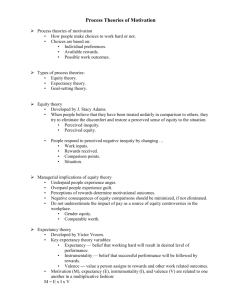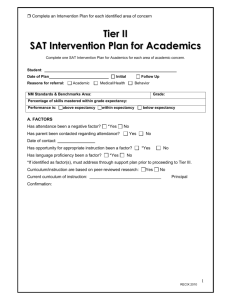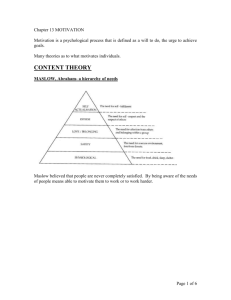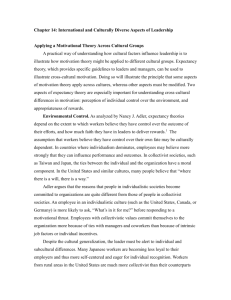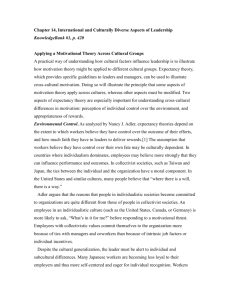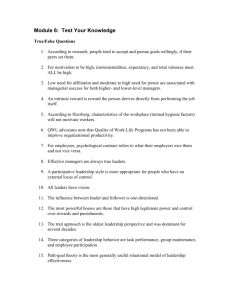Expectancy Theory of Motivation: Altering Expectations
advertisement
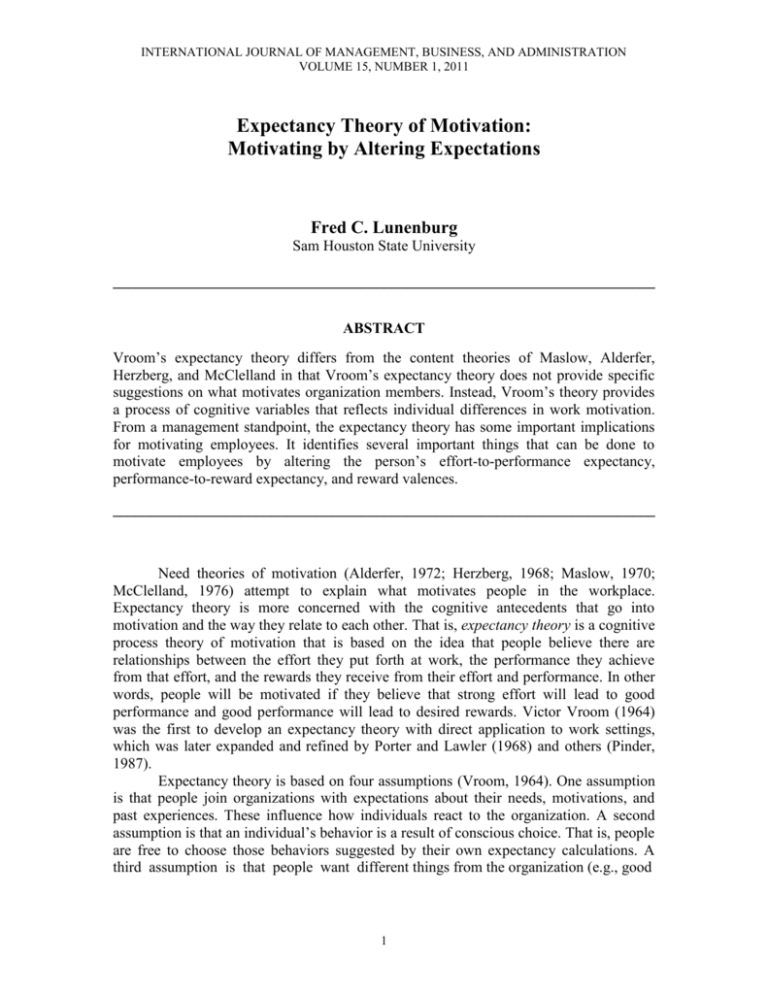
INTERNATIONAL JOURNAL OF MANAGEMENT, BUSINESS, AND ADMINISTRATION VOLUME 15, NUMBER 1, 2011 Expectancy Theory of Motivation: Motivating by Altering Expectations Fred C. Lunenburg Sam Houston State University ________________________________________________________________________ ABSTRACT Vroom’s expectancy theory differs from the content theories of Maslow, Alderfer, Herzberg, and McClelland in that Vroom’s expectancy theory does not provide specific suggestions on what motivates organization members. Instead, Vroom’s theory provides a process of cognitive variables that reflects individual differences in work motivation. From a management standpoint, the expectancy theory has some important implications for motivating employees. It identifies several important things that can be done to motivate employees by altering the person’s effort-to-performance expectancy, performance-to-reward expectancy, and reward valences. ________________________________________________________________________ Need theories of motivation (Alderfer, 1972; Herzberg, 1968; Maslow, 1970; McClelland, 1976) attempt to explain what motivates people in the workplace. Expectancy theory is more concerned with the cognitive antecedents that go into motivation and the way they relate to each other. That is, expectancy theory is a cognitive process theory of motivation that is based on the idea that people believe there are relationships between the effort they put forth at work, the performance they achieve from that effort, and the rewards they receive from their effort and performance. In other words, people will be motivated if they believe that strong effort will lead to good performance and good performance will lead to desired rewards. Victor Vroom (1964) was the first to develop an expectancy theory with direct application to work settings, which was later expanded and refined by Porter and Lawler (1968) and others (Pinder, 1987). Expectancy theory is based on four assumptions (Vroom, 1964). One assumption is that people join organizations with expectations about their needs, motivations, and past experiences. These influence how individuals react to the organization. A second assumption is that an individual’s behavior is a result of conscious choice. That is, people are free to choose those behaviors suggested by their own expectancy calculations. A third assumption is that people want different things from the organization (e.g., good 1 INTERNATIONAL JOURNAL OF MANAGEMENT, BUSINESS, AND ADMINISTRATION 2_____________________________________________________________________________________ salary, job security, advancement, and challenge). A fourth assumption is that people will choose among alternatives so as to optimize outcomes for them personally. The expectancy theory based on these assumptions has three key elements: expectancy, instrumentality, and valence. A person is motivated to the degree that he or she believes that (a) effort will lead to acceptable performance (expectancy), (b) performance will be rewarded (instrumentality), and (c) the value of the rewards is highly positive (valence). (See Figure 1.) Expectancy Effort Instrumentality Performance Rewards Valence Figure 1. Basic expectancy model. Expectancy Expectancy is a person’s estimate of the probability that job-related effort will result in a given level of performance. Expectancy is based on probabilities and ranges from 0 to 1. If an employee sees no chance that effort will lead to the desired performance level, the expectancy is 0. On the other hand, if the employee is completely certain that the task will be completed, the expectancy has a value of 1. Generally, employee estimates of expectancy lie somewhere between these two extremes. Instrumentality Instrumentality is an individual’s estimate of the probability that a given level of achieved task performance will lead to various work outcomes. As with expectancy, instrumentality ranges from 0 to 1. For example, if an employee sees that a good performance rating will always result in a salary increase, the instrumentality has a value of 1. If there is no perceived relationship between a good performance rating and a salary increase, then the instrumentality is 0. FRED C. LUNENBURG _____________________________________________________________________________________3 Valence Valence is the strength of an employee’s preference for a particular reward. Thus, salary increases, promotion, peer acceptance, recognition by supervisors, or any other reward might have more or less value to individual employees. Unlike expectancy and instrumentality, valences can be either positive or negative. If an employee has a strong preference for attaining a reward, valence is positive. At the other extreme, valence is negative. And if an employee is indifferent to a reward, valence is 0. The total range is from -1 to +1. Theoretically, a reward has a valence because it is related to an employee’s needs. Valence, then, provides a link to the need theories of motivation (Alderfer, Herzberg, Maslow, and McClelland). Vroom suggests that motivation, expectancy, instrumentality, and valence are related to one another by the equation Motivation = Expectancy x Instrumentality x Valence. The multiplier effect in the equation is significant. It means that higher levels of motivation will result when expectancy, instrumentality, and valence are all high than when they are all low. The multiplier assumption of the theory also implies that if any one of the three factors is zero, the overall level of motivation is zero. Therefore, for example, even if an employee believes that his/her effort will result in performance, which will result in reward, motivation will be zero if the valence of the reward he/she expects to receive is zero (i.e. if he/she believes that the reward he/she will receive for his/her effort has no value to him/her. Expectancy Theory in Practice: Key Managerial Implications Expectancy theory has some important implications for motivating employees. The model provides guidelines for enhancing employee motivation by altering the individual’s effort-to-performance expectancy, performance-to-reward expectancy, and reward valences. Several practical implications of expectancy theory are described next (Greenberg, 2011; Hellriegel & Slocum, 2011; McShane & Von Glinow, 2011; Nadler & Lawler, 1983). Effort-to-Performance Expectancy Leaders should try to increase the belief that employees are capable of preforming the job successfully. Ways of doing this include: select people with the required skills and knowledge; provide the required training and clarify job requirements; provide sufficient time and resources; assign progressively more difficult tasks based on training; follow employees’ suggestions about ways to change their jobs; intervene and attempt to alleviate problems that may hinder effective performance; provide examples of employees who have mastered the task; and provide coaching to employees who lack self-confidence. In essence, leaders need to make the desired performance attainable. INTERNATIONAL JOURNAL OF MANAGEMENT, BUSINESS, AND ADMINISTRATION 4_____________________________________________________________________________________ Good leaders not only make it clear to employees what is expected of them but also help them attain that level of performance. Performance-to-Reward Expectancy Leaders should try to increase the belief that good performance will result in valued rewards. Ways of doing so include: measure job performance accurately; describe clearly the rewards that will result from successful performance; describe how the employee’s rewards were based on past performance; provide examples of other employees whose good performance has resulted in higher rewards. In essence, leaders should link directly the specific performance they desire to the rewards desired by employees. It is important for employees to see clearly the reward process at work. Concrete acts must accompany statements of intent. Compensation mechanisms can be a powerful incentive in linking performance to rewards. Compensation systems that reward people directly based on how well they perform their jobs are known as pay-for-performance plans (Berger, 2009). These may take such forms as “commission plans” used for sales personnel, “piece-rate systems” used for factory workers and field hands, and “incentive stock option (ISO) plans” for executives (Dunn, 2009; Mercer, Carpenter, & Wyman, 2010) and other employees (Baker, 2011). However, rewards linked to performance need not be monetary. Symbolic and verbal forms of recognition for good performance can be very effective as well (Markham, Dow, & McKee, 2002). Valences of Rewards Leaders should try to increase the expected value of rewards resulting from desired performance. Ways of doing this include: distribute rewards that employees value, and individualize rewards. With a demographically diverse workforce, it is misleading to believe that all employees desire the same rewards. Some employees may value a promotion or a pay raise, whereas others may prefer additional vacation days, improved insurance benefits, day care, or elder-care facilities. Many companies have introduced cafeteria-style benefit plans—incentive systems that allow employees to select their fringe benefits from a menu of available alternatives. Another issue that may surface with expectancy theory is the need for leaders to minimize the presence of countervalent rewards—performance rewards that have negative valences. For example, group norms (see, e.g. the classic Hawthorne Studies, Mayo, 1933; Roethlisberger & Dickson, 1939) may cause some employees to perform their jobs at minimum levels even though formal rewards and the job itself would otherwise motivate them to perform at higher levels. Conclusion Vroom’s expectancy theory differs from the content theories of Maslow, Alderfer, Herzberg, and McClelland in that Vroom’s expectancy theory does not provide specific FRED C. LUNENBURG _____________________________________________________________________________________5 suggestions on what motivates organization members. Instead, Vroom’s theory provides a process of cognitive variables that reflects individual differences in work motivation. In this model, employees do not act simply because of strong internal drives, unmet needs, or the application of rewards. Instead, they are rational people whose beliefs, perceptions, and probability estimates influence their behavior. From a management standpoint, the expectancy theory has some important implications for motivating employees. It identifies several important things that can be done to motivate employees by altering the person’s effort-to-performance expectancy, performance-to-reward expectancy, and reward valences. References Alderfer, C. P. (1972). Existence, relatedness, and growth. New York, NY: Free Press. Baker, A. (2011). The stock options book. Oakland, CA: National Center for Employee Ownership. Berger, L. A. (2009). The compensation handbook: A state-of-the-art guide to compensation strategy and design. New York, NY: McGraw-Hill. Dunn, B. (2009). The brave new world of executive compensation: What do we do now? New York, NY: Aon Consulting. Greenberg, J. (2011). Behavior in organizations (10th ed.). Upper Saddle River, NJ: Prentice Hall. Hellriegel, D., & Slocum, J. W. (2011). Organizational behavior (13th ed.). Mason, OH: South-Western Cengage Learning. Herzberg, F. (1968). One more time: How do you motivate employees? Harvard Business Review, 46, 53-62. Markham, S. E., Dow, S. K., & McKee, G. H. (2002). Recognizing good attendance: A longitudinal, quasi-experimental field study. Personnel Psychology, 55, 639-660. Maslow, A. H. (1970). Motivation and personality (2nd ed.). Reading, MA: AddisonWesley. Mayo, E. (1933). The human problems of an industrial civilization. New York, NY: Macmillan. McClelland, D. C. (1976). The achieving society. New York, NY: Irvington Publishers. McShane, S. L., & Von Glinow, M. A. (2011). Organizational behavior (5th ed.). New York, NY; McGraw-Hill. Mercer, M. K., Carpenter, G., & Wyman, O. (2010). Pay for results: Aligning executive compensation with business performance. New York, NY: Wiley. Nadler, D. A., & Lawler, E. E. (1983). Motivation: A diagnostic approach. In J. R. Hackman & E. E. Lawler (Eds.), Perspectives on organizational behavior (pp. 6778). New York, NY: McGraw-Hill. Pinder, C. C. (1987). Valence-instrumentality-expectancy theory. In R. M. Steers & L. W. Porter (Eds.), Motivation and work behavior (4th ed.) (pp. 69-89). New York, NY: McGraw-Hill. Porter, L. W., & Lawler, E. E. (1968). Managerial attitudes and performance. Homewood, IL: Dorsey Press and Richard D. Irwin. INTERNATIONAL JOURNAL OF MANAGEMENT, BUSINESS, AND ADMINISTRATION 6_____________________________________________________________________________________ Roethlisberger, F. J., & Dickson, W. J. (1939). Management and the worker. Cambridge, MA: Harvard University Press. Vroom, V. H. (1964). Work and motivation. San Francisco, CA: Jossey-Bass.

